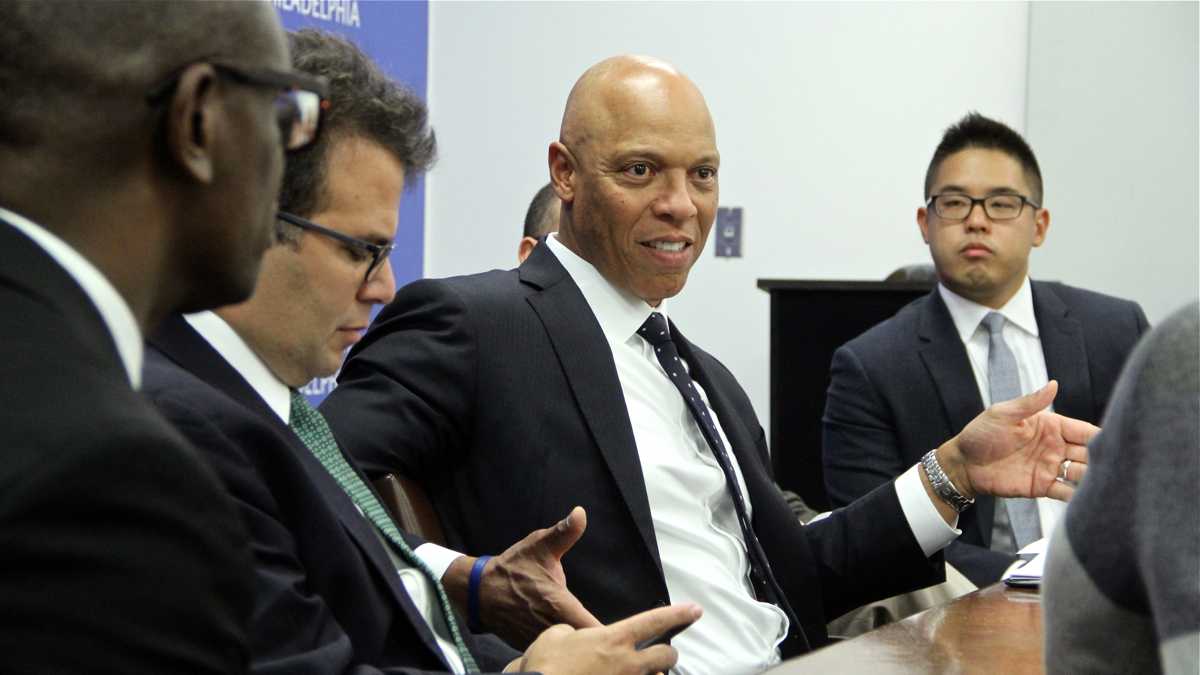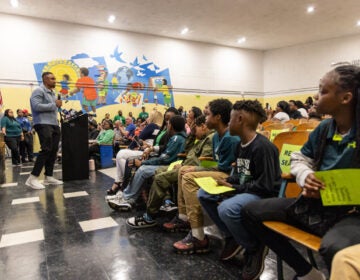Hite plan for Philly district: More charter conversions, closings, turnarounds and new schools
Listen
Philadelphia schools Superintendent William Hite talks about school openings, closings and charter conversions that would affect 5,000 students. (Emma Lee/WHYY)
Philadelphia Schools Superintendent William Hite announced a package of recommendations Thursday that will turn over three additional elementary schools to outside charter providers, while closing two middle schools, Beeber in Wynnefield and Leeds in East Mt. Airy.
The plans, which officials said will impact 15 schools, also include the creation of two non-selective, inquiry-based schools: a high school in North Philadelphia and a middle school in Powelton.
In addition, three schools will be subject to “in-district” turnaround, although neither the schools nor the specifics of the turnaround blueprint have been finalized.
Hite deemed the proposal, which he said comes with an estimated price tag of $15 to $20 million, a step toward his goal of improving equity in the district by “providing the opportunity for as many as 5,000 students to get in better schools close to where they live.”
He said it was a matter of urgency. For the schools slated for the so-called Renaissance charter conversion — Jay Cooke in Logan, Samuel Huey in West Philadelphia, and John Wister in Germantown — he noted that reading and math proficiency rates hover around 30 percent.
This initiative, which Hite says starts of the process of implementing his Action Plan 3.0, “builds on the success of the Renaissance charter program, reignites in-district turnaround efforts, and consolidates underperforming programs and launches new schools based on proven and innovative models and approaches.”
But critics immediately accused the district of once more blindsiding affected communities, creating more churn and disruption for vulnerable students, and relying on privatization even though charter providers have had mixed success in turning around District schools.
Helen Gym, a Democratic candidate for a City Council at-large seat, noted that nearly all the students in the affected schools are African-American, and said that far from promoting equity, this reorganization is exacerbating segregation.
“One of the biggest issues that we have with the school district is the need for communities to feel like they’re engaged in a process, rather than being dictated to,” said Gym. “Especially when those communities are predominantly communities of color, it’s really problematic when people feel like they’re left out of a process rather than being part of it.”
Philadelphia Federation of Teachers president Jerry Jordan said he was given a heads-up shortly before a morning press conference, when Hite called him.
He said he opposed creating more Renaissance charters, and told Hite he should focus on advocating for more resources for district schools instead of making “drastic internal moves.”
Creating community schools is a better strategy, Jordan said. “This is unacceptable.”
Hite argued that there will be a robust community involvement process for the three Renaissance conversions, starting now through Jan. 21, when the School Reform Commission will vote on the recommendations.
Three parents from each school will sit on the seven-member committee that develops the “request for qualifications” for providers, he said. There will be weekly meetings at the affected schools between now and Nov. 15.
A letter was sent to parents Thursday with information on the meetings. In December, Hite will recommend a provider to take over management at each of the three schools.
Parents’ role in Renaissance process
There are now 20 district schools that have been converted to charters under the Renaissance program, which started in 2010. For most of that time, the parent-dominated School Advisory Councils at the designated schools interviewed interested providers and made recommendations to the superintendent and SRC.
Two years ago, the district designated Muñoz-Marin and Steel Elementary for turnaround. Rather than have the SAC give input on a preferred provider, the district changed its procedures and, instead, conducted a vote on whether the school should be outsourced at all.
At both schools, the charter conversion was voted down after a hard-fought campaign in which the PFT and activists, including Gym, urged the community to reject that option. The district took a hiatus from Renaissance last year.
Hite denied that the new procedure is a reaction to not getting the result that the district wanted with Steel and Muñoz-Marin.
“The rationale … is that these schools have been chronically underperforming for many years,” he said. “In addition to that, we have evidence of success of Renaissance programs. … We want to make sure we expose more children to the type of education experienced in the Renaissance schools. More students read at grade level, more students do math at grade level, more students stay at these schools.”
He said last year that more than 1,800 students were turned away from Renaissance charters due to lack of capacity. The district could not immediately provide a school-by-school breakdown of where students were turned away, but said that students have been turned away by all 20 Renaissance schools.
The first cohort of seven Renaissance charters came up for renewal earlier this year, and four of them were renewed outright. One provider surrendered its school to another organization when Young Scholars arranged for its Douglass campus to be transferred to Mastery. Two others, Universal-Bluford and Stetson, operated by ASPIRA, are facing possible non-renewal.
The most successful turnaround provider has been Mastery, which now operates eight schools and is the only one that has had all its schools renewed this year.
Each of the three schools designated for Renaissance turnaround this year is within a mile of a Mastery high school. Officials said that this was not a factor in which schools were targeted.
“I applaud Superintendent Hite for putting kids first and moving towards an agenda which is about great schools irregardless of the type of school or who’s running the school,” said Mastery CEO Scott Gordon. “The fact that he made all those announcements today sent me that message.”
He also applauded the early timeline – in prior years, Renaissance provider assignments were not finalized until March or later – and said he is “excited and interested in learning more” but didn’t commit to submitting applications.
District officials said they are hoping to attract providers with a national footprint who aren’t now in Philadelphia, including Uncommon Schools. Marc Mannella, CEO of KIPP Philadelphia, which operates several schools in the city but does not do turnarounds, said he was “excited … to dig in here” and “assess if this is something that could help us reach our goal of getting to ten schools and expand our impact in Philadelphia.”
School closings
Although both Leeds and Beeber middle schools will close, the buildings will continue to be used.
Beeber, a large, stately old junior high school, now houses a second SLA high school campus as well as fewer than 200 sixth-, seventh- and eighth-graders, almost all of them economically disadvantaged and African-American. It was originally planned to be closed when SLA co-located in the building. Hite said achievement is low and about 80 percent of families in the catchment area opt to attend school elsewhere.
Leeds, in a leafy neighborhood in East Mt. Airy, shares space with Parkway Northwest, a high school that will remain on the third floor. Leeds has fewer than 300 sixth-, seventh-, and eighth-graders, which are 95 percent African-American and nearly all low-income. Test scores have been on the decline, according to district data.
Hill-Freedman, a special admission school with an International Baccalaureate curriculum, will move into the building. Current Leeds students will stay in the school through eighth grade, when they will then have to compete for spots in the high school.
New schools planned
The new high school will be affiliated with the national organization Big Picture, and be citywide admission with preference for its immediate area, which has yet to be chosen.
Last year the district opened three new “innovative” small high schools that focus on providing rich inquiry- and project-based learning to students not pre-selected for grades and behavior and who have been ill-served in traditional models. Demand for them has been high, said Hite, and they have seen improvements in attendance, course completion, and climate compared to traditional neighborhood schools.
Big Picture runs about 50 schools across the country, including one in Camden, and has a track record of success, said the district’s assistant superintendent for innovative schools Chris Lehmann. “You couldn’t find a better partner,” he said.
The middle school, to be built on the site once occupied by University City High School, will be modeled on Science Leadership Academy and will have ties to Drexel University, which now owns that site. It will draw from Powelton and Mantua, said Lehmann, who is also co-principal of SLA. It will open next fall and use rented space until the new facility is complete.
SLA Middle School will make a special effort to reach out to the poorer areas of Mantua and create a racially and socioeconomically diverse student body, he said.
“Powel has 60 children per grade, SLA Middle School will have 90 students per grade,” Lehmann said. “We think we will be serving an incredibly diverse student body [and be] able to serve historically challenged and underserved neighborhoods in that area. We’ve been reaching out to the Mantua community. We’re going to be sitting down at Mantua community meetings with laptops and with parents and helping them to apply.”
As for the new in-district turnarounds, details were sparse. “Promise Academies” were created at the same time as the Renaissance charters, and they got extra resources and adopted the “turnaround” strategy of requiring all teachers to reapply for their jobs, rehiring a maximum of half.
But the extra resources, including the longer day and year adopted by many of the more high-performing charters, soon fell victim to budget cuts, and the Promise Academy model lost its integrity
Hite and Eric Beacoats, the new assistant superintendent for turnaround, said that it wasn’t yet clear whether the three new schools would require faculty reshuffling, what the turnaround model will be, or what extra resources they will get.
Asked to respond to anticipated criticism that it would be better to use the $15 million to $20 million to shore up decimated staffs across the city, Hite said that there would not be enough money to even add one person to each school with that amount.
“The whole notion is to concentrate those investments to the schools most in need of those investments,” he said.
WHYY is your source for fact-based, in-depth journalism and information. As a nonprofit organization, we rely on financial support from readers like you. Please give today.





